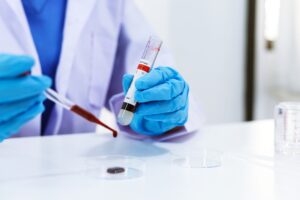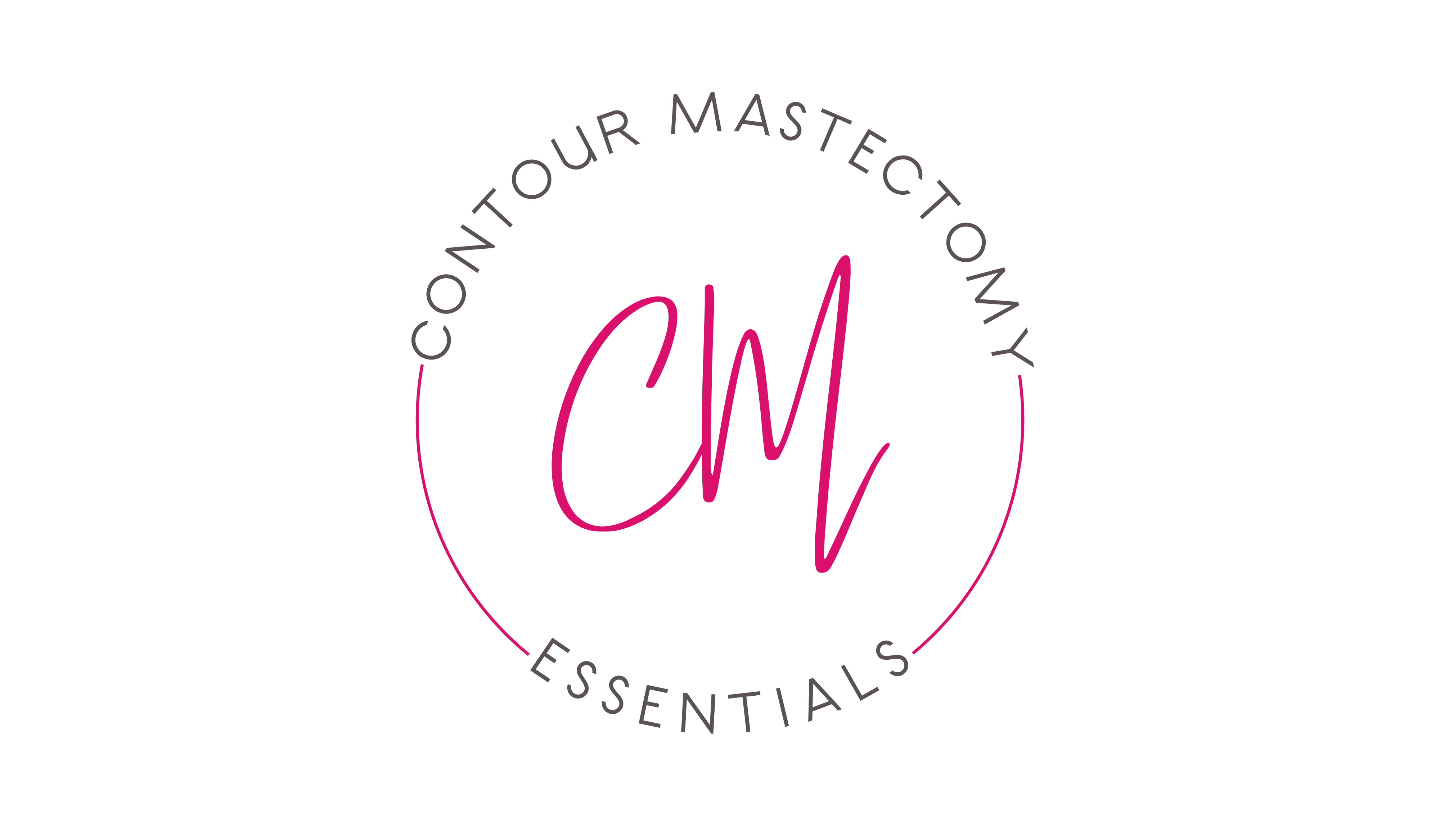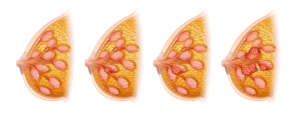Factors that may increase Breast Cancer
- Family history of breast and ovarian cancer. Your risk increases if a mother, sister or daughter is diagnosed with breast cancer. Red flags include multiple family members diagnosed at age < 45. Cancer risk can be inherited from your mother’s and father’s side of the family.
- Genetic mutations. You’re at a higher risk if you have family members with a mutation, especially BRCA1 and BRCA2 genes. Individuals with a hereditary risk for breast cancer may have up to an 85% lifetime breast cancer risk.
- History of abnormal breast biopsy. Atypical cells put you at higher risk.
- Dense breasts. Breasts comprised of more connective and glandular tissue and less fatty tissue have been associated with higher cancer risks.
- A high body mass index (BMI) of 25 or more. BMI is based on your weight and your height and indicates if you’re at a healthy weight. The higher your BMI, the higher your risk of developing cancer.
- Increasing age. Two out of three invasive breast cancers are found in women over the age of 55.
- History of chest wall radiation at a young age. For example, chest radiation for childhood lymphoma increases breast cancer risk.
How do I know my risk for Breast Cancer?
The risk for breast cancer is not the same for all women, as it depends on your individual health history and family history. A “high risk” designation can be determined by one factor or a combination of factors.
Even if you are in your 20s and 30s, a discussion with your healthcare provider about your breast cancer risk is encouraged. First and foremost, know your family history. This is an essential initial step.
What are the marker numbers for breast cancer?
Some examples of tumor markers in breast cancer are CA 15-3 and CA 27.29: These are two related markers that breast cancer cells make in higher amounts. As such, when a test detects them in the blood, they can signal the presence of breast cancer.
What is an aromatase inhibitor?
An aromatase inhibitor (AI) is a type of hormone therapy for cancer. Healthcare providers use aromatase inhibitors to treat hormone receptor-positive (ER-positive) breast cancer. ER-positive breast cancer often affects women who are age 50 and older.
Aromatase inhibitors work by reducing the amount of estrogen in your body. Estrogen is an essential hormone. It supports your sexual and reproductive health. It also regulates critical processes in your skeletal, cardiovascular, and central nervous systems that affect your overall health.
However, high estrogen levels may increase your risk of developing ER-positive breast cancer. Aromatase inhibitors block the enzyme aromatase, which turns other hormones into estrogen. By reducing estrogen levels, aromatase inhibitors keep cancerous cells from growing and spreading.
Providers typically use aromatase inhibitor therapy for people with breast cancer who’ve gone through menopause. (Women who haven’t gone through menopause usually don’t receive aromatase inhibitor therapy because their ovaries are still making estrogen.)
Aromatase inhibitors also keep ER-positive breast cancer from recurring or coming back after breast cancer surgery. If you have an increased risk of developing ER-positive breast cancer, taking an aromatase inhibitor may reduce your risk.
What is the survival rate without aromatase inhibitors?
If you have ER-positive breast cancer, aromatase inhibitor therapy significantly reduces your risk that breast cancer will come back. One early study compared outcomes for those who took the aromatase inhibitor letrozole after tamoxifen and people who didn’t. The study showed that taking letrozole reduced the risk of dying of breast cancer by 24% to 35%.
The three aromatase inhibitor drugs are:
The Breast Cancer Index Test
The Breast Cancer Index genomic test, a crucial tool in your treatment plan, analyzes the activity of 11 genes. These genes can influence the likelihood of the cancer returning 5 to 10 years after diagnosis and your potential benefit from 5 additional years of hormonal therapy.
The BCI Prognostic result, a precise estimation, determines the likelihood of cancer returning 5 to 10 years after diagnosis (late recurrence). This result, given as a percentage, provides a clear understanding. For instance, a prognostic result of 2.2% means that you have a 2.2% risk of cancer recurring 5 to 10 years after diagnosis.
The BCI Predictive result, reported as a clear ‘yes’ or ‘no,’ carries significant implications. A ‘yes’ result indicates a high likelihood of benefiting from 5 more years of hormonal therapy, offering hope for extended treatment. Conversely, a ‘no’ result suggests that this therapy may not be beneficial, guiding towards alternative options.
Michelle Beck, shares her experience with the Breast Cancer Index
Genomic Testing
Genomic tests are a unique tool in cancer treatment. They analyze a cancer tumor sample to determine the activity of specific genes. The activity level of these genes is a key factor in cancer’s behavior, including its growth and spread. This reassures patients and caregivers that decisions about additional treatments after surgery are based on the most advanced and personalized information available.
Genomic and genetic testing are distinct processes with different purposes and outcomes despite their similar names. This knowledge will help you navigate the world of cancer treatment options with clarity and confidence.

Genetic testing is done on a sample of your blood, saliva, or other tissue and can tell if you have a change (also called a mutation) in a gene that is linked to a higher risk of breast cancer.
What to Expect – Breast Cancer Index Testing
The test provides two pieces of valuable information to help make a personalized decision: Whether an additional five years of anti-estrogen therapy is likely to help reduce your risk of cancer returning. Your risk of recurrence after 5 years is based on your original tumor biology.
The Breast Cancer Index test, made by Biotheranostics, analyzes the activity of 11 genes to help predict the risk of early-stage, hormone-receptor-positive breast cancer coming back 5 to 10 years after diagnosis. The test can help women and their doctors decide if extending hormonal therapy five more years (for a total of 10 years of hormonal treatment) would be beneficial.
Am I eligible for the Breast Cancer Index Test?
The potential benefits of the Breast Cancer Index test await you if you meet the following criteria:
- You were diagnosed with early-stage (stage I-III) breast cancer
- The cancer was hormone-receptor-positive
- There was no cancer in your lymph nodes (lymph node-negative disease), or the tumor is lymph node-positive and is in one, two, or three lymph nodes.
- You’ve been taking hormonal therapy for 4 to 5 years and want to know if taking hormonal therapy for more time will be beneficial.
Research has shown that extending hormonal therapy for five more years — for a total of 10 years of hormonal therapy — can offer benefits for some women diagnosed with early-stage, hormone receptor-positive disease.
The Breast Cancer Index test is a safe and noninvasive procedure that analyzes preserved tissue removed during the original biopsy or surgery. While the test is generally well-tolerated, there is a small risk of complications, such as infection at the biopsy site. Discussing these risks with your healthcare provider before deciding to undergo the test is essential.
Understanding the potential side effects of hormonal therapy is crucial. Many women experience troubling side effects, such as hot flashes and joint pain. It’s essential to weigh these against the potential benefits of extended therapy.
Will my insurance or Medicare cover the Breast Cancer Index?
The Medicare program and several other major insurance companies have agreed to cover the Breast Cancer Index Test when specific criteria are met. You can find detailed information on the requirements under the Local Coverage Determination at CMS.gov or by contacting Biotheranostics, Patient Services Team. They will assist you in verifying insurance coverage and understanding out-of-pocket costs, ensuring you receive the necessary support. The company also has a patient assistance program that helps pay for testing. To contact the Patient Services Team, call 1-844-319-8111. The email address is [email protected].
SUMMARY
The Breast Cancer Index Test offers several benefits in guiding treatment decisions. Firstly, it helps identify patients at a higher risk of recurrence, allowing for more aggressive treatment approaches. Conversely, it also identifies patients who have a lower risk of recurrence, enabling them to avoid unnecessary treatments and their associated costs. The Breast Cancer Index Test improves the overall quality of care and patient outcomes by tailoring treatment plans with extended endocrine therapy that will benefit patients.
This is important because of the side effects that patients commonly experience, including osteoporosis, bone fractures, and joint pain, according to Biotheranostics. These conditions can negatively affect a patient’s quality of life. This test can help personalize endocrine therapy for all patients with HR-positive breast cancer and help patients avoid what’s called overtreatment.
References
BreastCancer.org
Cleveland Clinic
Healthline
Mayo Clinic
SummaHealth









